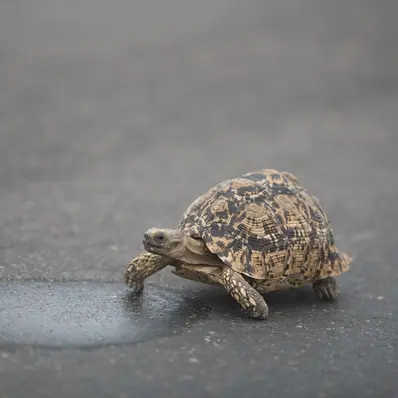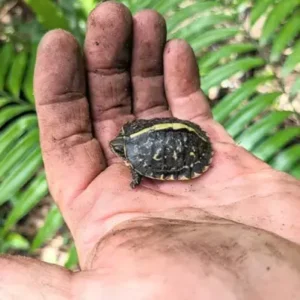History/Origin
Bog turtles have been around for a really long time, millions of years, in fact. They’re originally from the eastern United States and are experts at living in wetlands, especially in places called sphagnum bogs.
These bogs are like their special homes where they’ve learned to survive and thrive over a very, very long time.
The combination of ancient heritage and ecological specialization makes bog turtles a captivating subject in the narrative of American wildlife.
Personality
Take a closer look at the Bog turtle’s specific traits that shape its personality.
- They are Shy and Reserve
Bog turtles are renowned for their shy and reserved disposition. These small reptiles often retreat into their protective shells when they sense any potential threats. This cautious nature helps them navigate their delicate ecosystems with a keen awareness of their surroundings.
- They are Resilient
Despite being small, bog turtles show a strong determination. In their habitats, they persistently navigate wetlands and marshy areas, highlighting their adaptability and survival skills.
- They are Ecological Stewards
Beyond their individual characteristics, bog turtles play a crucial role in the broader ecological tapestry. As integral components of wetland ecosystems, they contribute to the delicate balance of biodiversity. Their feeding habits, nesting behaviors, and interactions with other species make them silent but impactful guardians of their habitats.
Physical Appearance of Bog Turtle
In the wetlands of the eastern United States, bog turtles have a captivating look. As the smallest North American turtles, they showcase the intricate beauty of nature’s design, adding to their charm.
- Size
Adult bog turtles enchant observers with their petite size, measuring between 3.5 to 4.5 inches. Despite their small stature, every inch of bog turtles contributes to their agility and ability to move easily in the lush landscapes they inhabit.
- Color
The defining feature of the bog turtle is its shell, a masterpiece of nature’s artistry. The shell, primarily dark brown or black, features lively orange or yellow markings These striking patterns not only distinguish them but also help camouflage them in their boggy homes.
Gender Differences
Distinguishing between male and female bog turtles can be challenging, with subtle differences in size and behavior. Males may have slightly longer tails, while females might showcase more reserved behavior, especially during nesting periods.
Nutrition
A diverse diet is critical for the health of bog turtles, influencing their individual well-being. They play a key role in sustaining the ecological balance of wetland ecosystems.
- Invertebrates: Bog turtles consume worms, snails, and insects, gaining essential proteins crucial for growth, energy, and bodily functions.
- Insects: Insect-rich meals provide vital proteins and fats, serving as natural enrichment to stimulate foraging behaviors and mental well-being.
- Vegetation: Including aquatic plants and grasses, vegetation offers fibers and nutrients, contributing to a well-rounded nutritional profile.
- Vitamins and Minerals: Supplementing with necessary vitamins and minerals, such as calcium, support shell development and overall skeletal health.
Health
Bog turtles, while resilient, can face various health issues, and understanding these challenges is crucial for their well-being.
Common health issues include:
Respiratory Infections
- Symptoms: Labored breathing, wheezing, or nasal discharge.
- Causes: Incorrect humidity levels, poor ventilation, or exposure to respiratory pathogens.
- Prevention and Treatment: Maintain optimal habitat conditions, ensure proper ventilation, and promptly address respiratory issues with veterinary care.
Shell Infections and Damage
- Symptoms: Also known as shell rot develop symptoms of shell discoloration, soft spots, or visible injuries.
- Causes: Rough substrate, inadequate basking areas, or bacterial/fungal infections.
- Prevention and Treatment: Provide a suitable substrate, monitor basking conditions, and seek veterinary assistance for shell health concerns.
Parasitic Infections
- Symptoms: Weight loss, lethargy, or changes in fecal appearance.
- Causes: Exposure to internal parasites in their environment.
- Prevention and Treatment: Conduct regular fecal examinations, practice good hygiene, and consult a veterinarian for appropriate deworming.
Dehydration
- Symptoms: Sunken eyes, lethargy, or dry skin.
- Causes: Inadequate access to water, low humidity, or illness.
- Prevention and Treatment: Ensure a constant and accessible water source, maintain proper humidity, and address dehydration promptly with veterinary guidance.
Dietary Issues
- Symptoms: Weight loss, malnutrition, or refusal to eat.
- Causes: Inappropriate diet composition or feeding habits.
- Prevention and Treatment: Tailor the diet to their age and size, provide a variety of foods, and seek veterinary advice for optimal nutrition.
Injuries from Predators
- Symptoms: Visible wounds or trauma.
- Causes: Encounters with predators in outdoor habitats.
- Prevention and Treatment: Implement predator-proof enclosures, monitor outdoor habitats, and seek veterinary care for injuries.
Care and Grooming
Creating a suitable environment that mimics their natural habitat is crucial for the well-being of bog turtles. Maintain proper humidity levels, provide a basking area, and ensure a clean water source. Grooming involves monitoring shell conditions and addressing any abnormalities.
Conservation and Restoration Programs
Bog turtle conservation programs play a vital role in safeguarding this endangered species and its fragile habitats. Several initiatives and strategies are in place to address the conservation needs of bog turtles, including:
Species for Sale
Due to their endangered status and legal protections, bog turtles are not suitable for sale as pets. It is important to support conservation efforts and adhere to regulations that aim to preserve their natural populations.
Interesting Facts
- While generally shy, bog turtles communicate using a range of subtle signals, including body language and vocalizations.
- These turtles are skilled at modifying their surroundings, creating burrows and nests that contribute to the ecological diversity of their habitats.
- Bog turtles can exhibit a remarkable ability to blend into their surroundings, using their unique shell patterns for effective camouflage.
- Despite their small size, bog turtles may travel considerable distances within their habitats, showcasing an unexpected nomadic behavior.
- Unlike some other turtle species, bog turtles are selective about their basking spots, often choosing specific locations for optimal sun exposure.
Best For
Best known for their ecological significance, bog turtles are not recommended as home pets. Due to their endangered status and specialized habitat needs, they thrive best in the wild.
Top Names
| Male Bog Turtle Names | Female Bog Turtle Names |
| Bogart | Misty |
| Swampy | Lily |
| Muck | Pebble |
| Reedy | Fern |
| Puddle | Dottie |










